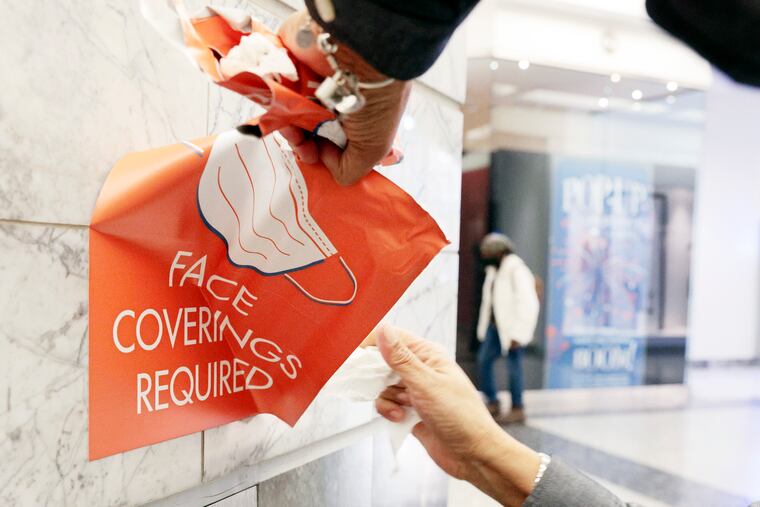We can’t afford an increase in COVID cases — literally | Opinion
I don’t know how high cases and hospitalizations will rise as a result of the newer COVID strain. I just know that, whatever happens, we probably aren’t prepared for it.

If the term “BA.2″ means nothing to you, count yourself lucky. That may be about to change.
BA.2 is a version of the omicron variant of COVID-19. The BA.1 form came on fast and furious over the winter — in the form of the omicron surge that killed 9,000 people in Pennsylvania alone. Then it seemed to retreat as quickly as it arrived, leaving us dazed but hopeful that the worst of this horrible time in human history might be behind us.
I have been hopeful, too. My kid, age 8, is vaccinated, and when she decides not to wear a mask, I don’t freak out. (This is progress.) I will always worry about those who remain vulnerable to COVID-19, such as the elderly and people with compromised immune systems, and I ache for the people who are mired in grief over those they’ve lost. But in my little family unit, I felt lucky. It looked like we would be OK.
So when I saw COVID cases start to rise in Europe a couple of weeks ago, I tried to look away. Same with reports about increasing levels of viral particles in wastewater in the Boston area, and elsewhere. But now that BA.2 has become the dominant strain of COVID in the U.S., and cases are inching up in our area, I can no longer pretend things are fine.
» READ MORE: The BA.2 subvariant is now dominant in the U.S., and cases are already starting to inch back up in New Jersey
I have no idea how bad BA.2 will be, and how high cases and hospitalizations will rise as a result. So far, data suggest that the strain is more contagious than others but may not cause more serious illness. Experts have said they expect infections will rise temporarily, but may not spike to the scary levels we’ve seen before. Even though around a quarter of Philadelphia residents aged 12 and up are not fully vaccinated (and the number of unprotected kids aged 5 to 11 is way more depressing), a lot of people were recently infected with the BA.1 form of omicron, which should help shield them from BA.2.
Whatever happens, though, we probably won’t be prepared for it.
I got a haircut last weekend in Huntington Valley, and I felt like I had traveled back in time — all the way back to 2019. In the tiny, overheated salon packed with people hugging and laughing and coughing out hairspray, I was the only person I saw who wore a mask. Even Philadelphia schools, which have been relatively COVID-cautious — requiring double-masking while other districts were taking them off — ended their mask mandate in early March.
“When it comes to COVID, the country can’t just ‘wait and see,’ then allocate funds if cases start to rise. We have to act in advance.”
Our sudden shift to mask-free living means that once BA.2 (or any new variant) hits our area, it could quickly infect anyone who remains vulnerable. (And let’s be honest: Now that we’re living like it’s 2019, everyone isn’t going to instantly throw on their masks if cases rise again.)
Here’s what’s more concerning: We can’t afford a spike in cases. Literally.
In March, Congress passed a spending bill that cut billions in COVID funding. Without this money, the Biden administration says it may not be able to pay for booster doses, new vaccines targeted to future (perhaps more deadly) strains, or life-saving treatments. By spring, we may run out of monoclonal antibodies — the amazing cocktails that have helped revolutionize COVID care. Without more funding, the U.S. may not be able to help vaccinate people around the world, thereby increasing the chance that additional variants will emerge, putting us all at risk.
When it comes to COVID, the country can’t just “wait and see,” then allocate funds if cases start to rise. We have to act in advance so that we can make and stockpile vaccines, treatments, and tests. Otherwise, they won’t be ready to distribute when the need arises.
Keep in mind that we aren’t really in a COVID lull, either — a new report shows that, just a few weeks ago, COVID hospitalization rate for Black people was higher than it had been for any racial or ethnic group at any point in the pandemic. The virus is still causing hundreds of deaths every day in the U.S.
As a nation, we need to do a better job of preparing for BA.2, or whatever version of COVID takes over next. I know there are many other budget items we need to pay for, and we are all so, so tired of the pandemic. But we can’t look away just yet.
Alison McCook is an assistant opinion editor.